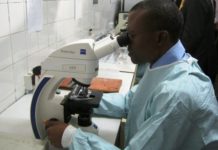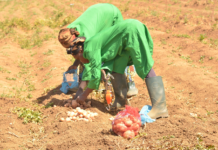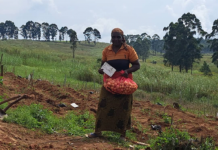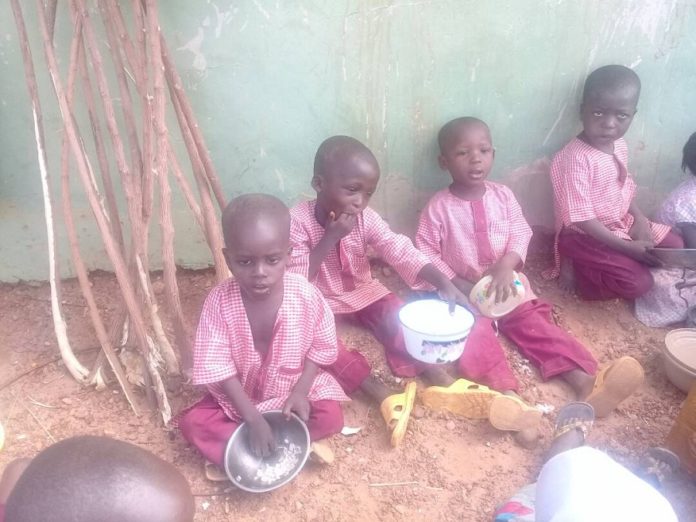By Ndidichukwu Odoh
Tudun Wada Primary School in Talata Mafara, Zamfara State houses over 650 school children.
Pupils in Primary one to six gather to seek knowledge and also get their daily meal.
At 11 am every school day, the children are served food, thanks to the Nigeria School Feeding Programme which has increased school enrolment and reduced out-of-school crisis.
But it has failed to address the poor quality of food given to the children especially those below the age of five. It worsens malnourishment in children.
“Ina nama ah abincin nka?” – where is the meat in your food?
“Ba mu a samu nama”- We don’t get meat.
“Ka ci nama ko kifi kuwa?” You don’t eat meat or fish at all?
“Gwamnati suna zuwa.” – When government people are coming.
Nine years old, Abubarka Mustapha is a primary four pupil of Tudun Wada Primary School in Talata Mafara Zamfara State, and could mutter few responses as he eats his food—white rice and beans combo served to the pupils.
Weekdays are for good meals; every child goes to school with plates to get their daily meals.
Children aged three to 13 years are the beneficiaries: once you are enrolled in a public school; you have the right to eat whatsoever is served.
Parents now worry less about breakfast and lunch.
When served, they dip fingers in the plate to pick their food: no one worries about spoons.
Sometimes the food is watery. Often rice and beans are cooked together with groundnut oil. No hint of tomatoes in the meals despite the huge production in Nigeria.
Looking at the quality of the food and portion given to each child, one could hear poverty screaming loud and malnutrition ravaging children below the age of five.
While malnutrition crisis worsens in Nigeria, the 2016 Multiple Indicator Cluster Survey (MICS) also shows that more than a quarter of primary and secondary school-age children are out of school (27% and 26% respectively).
However, Muhammad Alkali, the school’s Primary five and six teacher is happy the school feeding programme brought more children in the Mafara community to school.
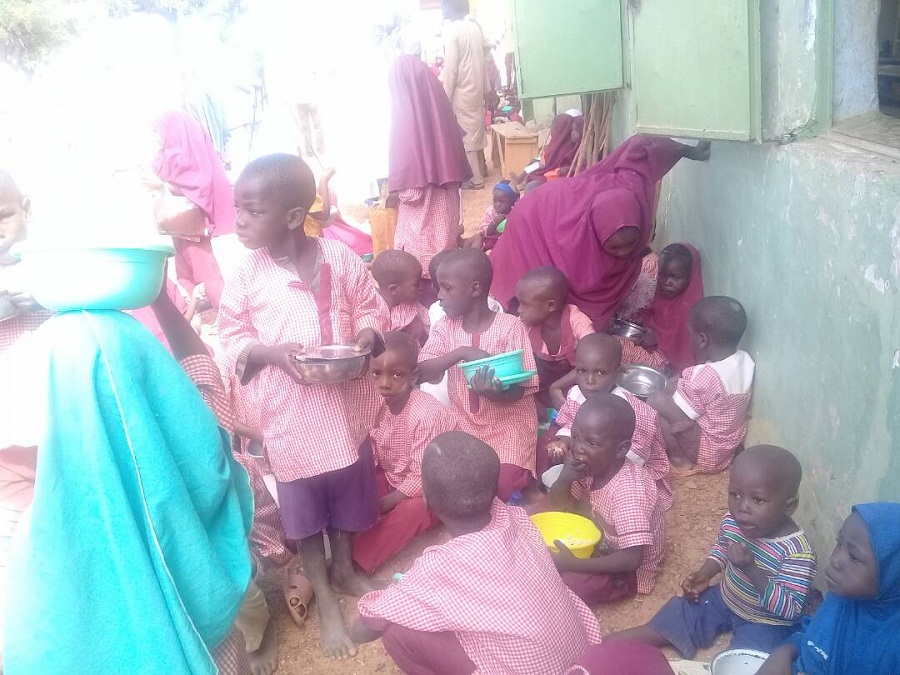
Nigeria has the highest number of severely malnourished children in Africa.
Over 13 million children are suffering from chronic malnutrition, also called stunting.
This makes it the country with the highest number of stunted children in Africa, and second highest in the world.
There are an estimated 2.5 million children with severe acute malnutrition (SAM), an extremely dangerous condition that makes children nine times more likely to die from common childhood illnesses such as diarrhoea, pneumonia and malaria.
Children with severe acute malnutrition are nine times likely to die.
The burden of SAM is more severe in the north than in the south with between 60-80% of SAM cases found in Northern Nigeria.
Without treatment, over 400,000 of them were estimated to die in 2016 alone.
As a developing country, Nigeria must balance its investment in education and health, Sunday Okoronkwo, programme manager for Civil Society Scaling up Nutrition (CSSUNN), says.
“To improve welfare and economic growth in Nigeria, investment in reducing undernutrition must be ranked ahead of investments in schooling, health and family planning,” he says.
“We are excited that there is a school feeding programme going on in public schools, but we are not certain about the quality of the food served to the children, especially those that are still below the age of five.” he said.
He said good nutrition and proper feeding contributes to a child’s cognitive development.
“For every dollar invested in reducing chronic undernutrition among children in Nigeria, there is a return of investment of $16 dollars. Sadly, we lose 3% to 16% of our GDP annually to malnutrition. Nutrition influences the development and productivity of an individual, family, community and a nation. Investment within the first 1000 days, provides greatest opportunity and healthy start of life,” Okoronkwo said.
Not paying attention to the effects of malnutrition on the country’s economy is an economic disaster waiting to happen.
Currently, the country is struggling with a budget of $23 billion for 193.3 million people.
Joblessness is very high at 18.80 per cent; the national debt stock is N23.7 trillion (March 2018). This has worsened poverty.
According to a new report by the Brookings Institution, Nigeria has overtaken India as the country with the highest population of extremely poor people with 87 million persons in the sorry state.
The African Development Bank says 80 per cent of Nigerians are so poor that they live under the $2 per day World Bank threshold.
In the 2018 World Poverty Clock, Nigeria also leads with 86.9 million poor people and is closely followed by India with 73 million and D.R Congo with 60.9 million people.
Ethiopia is next with 23.9 million people, followed by Tanzania with 19.9 million.
Mozambique comes next with 17.8 million while Kenya has 14.7 million people living in extreme poverty.
The least four are Uganda, South Africa, South Sudan and Zambia with 14.2, 13.8, 11.4 and 9.5 million people respectively.
A medical specialist, Dr Uzoma Igwe says that Nigeria, due to several insecurity challenges and worsening economic situation, might experience more issues in child malnutrition especially in areas where children are very vulnerable.
According to Dr Igwe, “It is important to approach economic development from various sectors, we must pay attention to nutrition, a well fed child has a better chance of surviving childhood diseases and can also be more intelligent than those who were malnourished at childhood.”
The MICS suggests that the North West and North East have the highest number of out-of-school children in the country. The school feeding programme has helped families unable to provide enough meals.
Children eat at school instead. But what is worrisome is what is served in school. The quality of the meal and the diseases the children could be exposed to.
In curbing poverty as one of the drivers of malnutrition the government will need to look beyond establishment of more programmes, but strengthen accountability mechanisms to monitor the school feeding programme to ascertain the impact of the huge funds invested in this programme. That way children like Abubarkar can have protein in their food not necessarily ‘when government people are coming’.
It is also important to beef up the activities of Presidential Committee on the North East Initiative (PCNI), and the Victim Support Fund for effective and efficient response to malnutrition.
More needs to be done to reach the unreached. There is need to improve livelihood of the citizenry.
Also a national programme should be heterogeneous in design to accommodate for a huge number of children who are malnourished, majority of them in Northern Nigeria due to increased displacements.
Advocacy and increased awareness on how to create balanced meals with minimal resources needs to be scaled up.
Mothers should also be taught how to feed their children and rely less on the school feeding as they also need to recognise symptoms of malnutrition and should be encouraged to seek help when their children fall sick.




